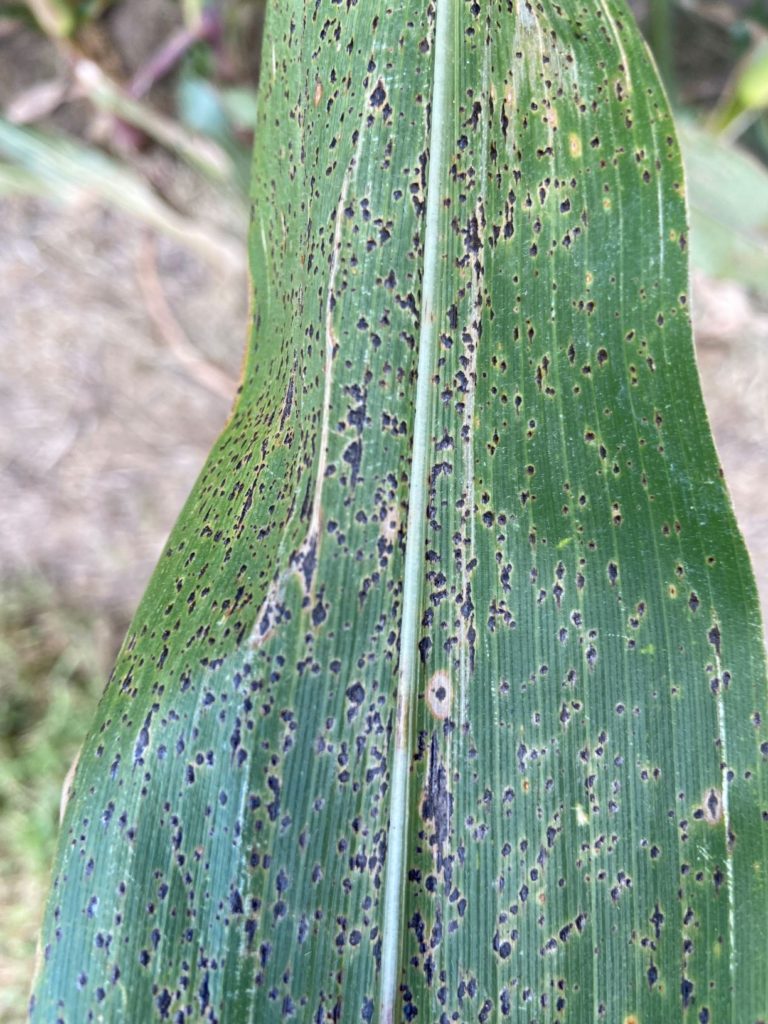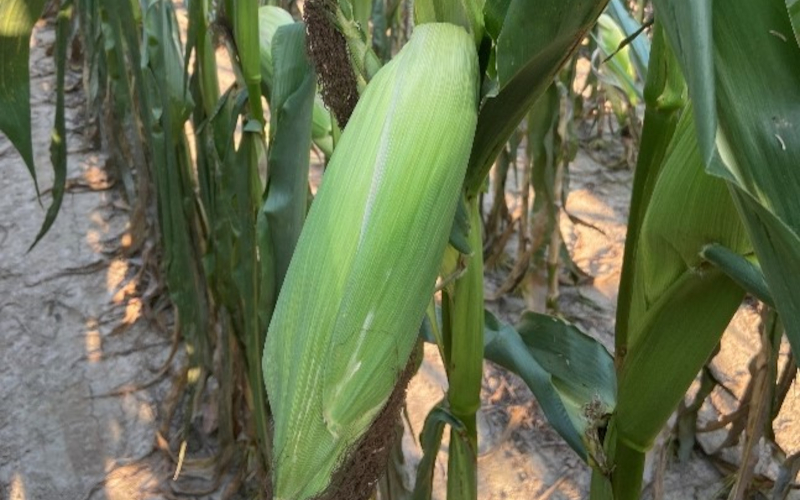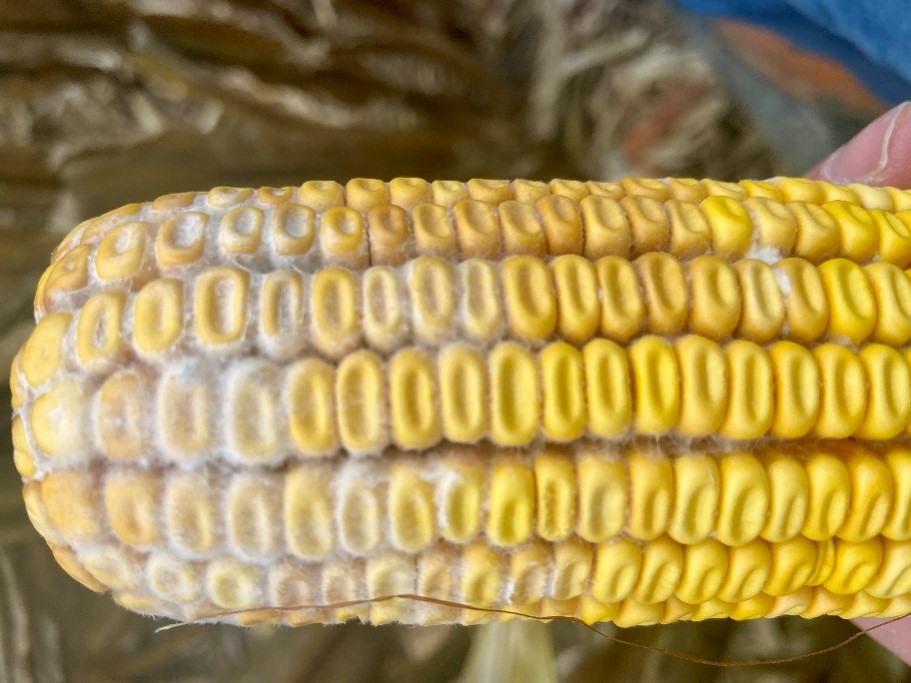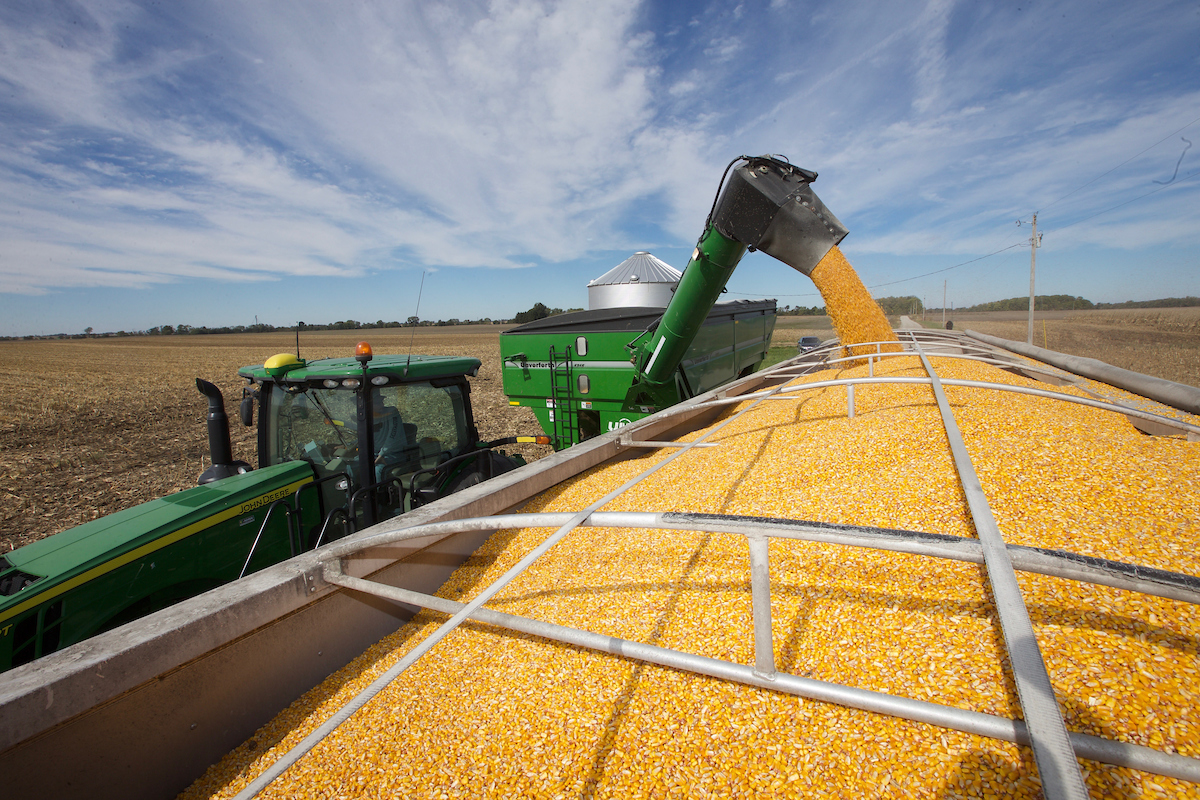What is Tar Spot?
Due to its relatively recent U.S. discovery and its ability to cause significant production and economic losses, tar spot is often a topic of angst and anxiety amongst corn farmers and agronomists in Indiana. For example, a severely infected field can reach yield losses upwards of 60 bushels per acre! Yield losses are often a result of reduced photosynthetic capacity (green leaf area) of the corn plant during grain fill resulting in poor grain fill, kernel abortion, and reduced kernel weight. In addition, severe infection can reduce corn stalk integrity and cause significant lodging later in the season. Tar spot was first confirmed in northwest Indiana in 2015 and the first significant yield-reducing event of the disease was observed in 2018. Similarly, severe outbreaks and large areas of infection of this disease were observed in Indiana in 2021. Tar spot is caused by the fungus known as Phyllachora maydis and can be identified by small, raised black and circular spots present on corn leaves, stalks, and husks (Figure 1). These black and circular spots are known as fungal fruiting structures called stromata, each of which can produce thousands of spores. Overall, tar spot infection and severity can vary based on environmental conditions, the total amount of the pathogen present in the field, and corn hybrid chosen.

Figure 1. Tar spot infection presence on a corn leaf during 2022. Photo: Dan Quinn.
What Conditions Cause Tar Spot?
Tar spot pressure in corn is fueled by cool (60-70 degrees F), humid conditions (>75% relative humidity) and prolonged leaf wetness (>7 hours). Therefore, tar spot pressure is typically higher in areas such as those closer in proximity to the great lakes (e.g., Northwest Indiana), river bottoms, and irrigated corn acres. Furthermore, it is also important to note that previous research has found that the pathogen that causes tar spot can overwinter on infested corn residue on the soil surface, thus causing crop infection risks in the following year(s).
How do I manage Tar Spot?
Crop Scouting and Diagnosis – In order to properly manage problems in your fields, it is important to identify which specific problems are present in your fields. Proper diagnosis and early detection of tar spot is critical for successful management of the disease. Tools such as the Tar Spot Distribution map (https://corn.ipmpipe.org/tarspot/) and the Tar Spotter app (https://ipcm.wisc.edu/apps/tarspotter/) are useful tools for tracking the presence of tar spot in your specific county and recognizing conditions conducive for tar spot development.
Fungicide Use – Currently, there are multiple fungicides from multiple companies that work to help control tar spot in corn. The fungicide efficacy chart available through the Crop Protection Network is a useful tool for fungicide selection based on disease presence in the field. However, fungicide efficacy is often largely controlled by fungicide timing. In most instances, a fungicide application between the VT growth stage (tassel emergence) and R2 growth stage (blister) is the most effective for controlling tar spot. Furthermore, a mixed-mode-of-action fungicide product is often more effective than a single-mode-of-action product. In severe tar spot situations, as what was observed in certain areas in 2021, two fungicide applications may be required. However, this is often dictated by history of severe disease and conducive environmental conditions in a field, and reiterates the importance of tracking the disease and field scouting.
Hybrid Selection – At the moment there are no corn hybrids with complete resistance to tar spot. However, different hybrids show different levels of partial resistance which can be effective in reducing tar spot severity. It is important to work with your seed company and examine local hybrid trials for proper hybrid selection to help with tar spot control. In addition, if you have tar spot in your fields, scout and pay attention to the different hybrids planted across your farm later in the season and at harvest for noticeable differences in tar spot severity and yield.
Cultural Practices – Practices that help reduce infested corn residue and reduce the survival of tar spot fungal structures can help reduce tar spot presence in corn fields. The two common practices for reducing disease inoculum include crop rotation and tillage. Rotation away from corn to soybeans allows for further breakdown of infested corn residue. In addition, tillage can help bury infested corn residue and reduce fungal spore movement. However, these practices can produce mixed results and are not the sole solution for preventing tar spot.
New Research
Starting in 2022, Drs Telenko and Quinn will begin examing the role of corn planting date, corn hybrid relative maturity date, and fungicide use on tar spot severity, corn growth, grain fill potential, and yield. Planting date and corn hybrid relative maturity are two strategies that can be used to manipulate the timing corn reaches critical growth stages (e.g., pollination) and physiological maturity (e.g., black layer) during the season. Previous research has identified the optimum fungicide application in most years for tar spot control to occur at growth stage VT/R1 (tassel emergence/silking) to R2 (milk), with minimal yield responses to a later fungicide application at the R4 growth stage (dough) and beyond. Therefore, can the combination of earlier planted corn and/or shorter-season hybrids be used to reach critical growth stages earlier, thus causing tar spot infection to occur later in the corn growth cycle and reduce yield loss and fungicide dependence? Stay tuned for updates from this research trial coming soon.
Additional Resources
Purdue University Plant and Pest Diagnostic Laboratory
Purdue University Field Crops Pathology
Purdue University Corn Agronomy
References
Smith, D., and R. Schmidt. 2021. Tar Spot of Corn is Here to Stay. WCM Newsletter. University of Wisconsin-Madison Ext. https://ipcm.wisc.edu/blog/2021/10/tar-spot-of-corn-is-here-to-stay/
Telenko, D., and T. Creswell. 2019. Diseases of corn: Tar spot. Bull. BP-90-W. Purdue University Ext., West Lafayette, IN. https://www.extension.purdue.edu/extmedia/bp/bp-90-w.pdf
Telenko, D., Chilvers, M., Kleczewski, N., Mueller, D., Plewa, D., Robertson, A., Smith, D., Sisson, A., Tenuta, A., and Wise, K., 2021. Tar spot of corn. Crop Protection Network. CPN 2015. doi.org/10.31274/cpn-20201214-2.





